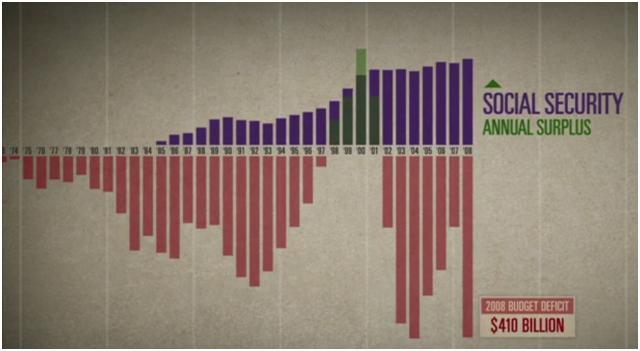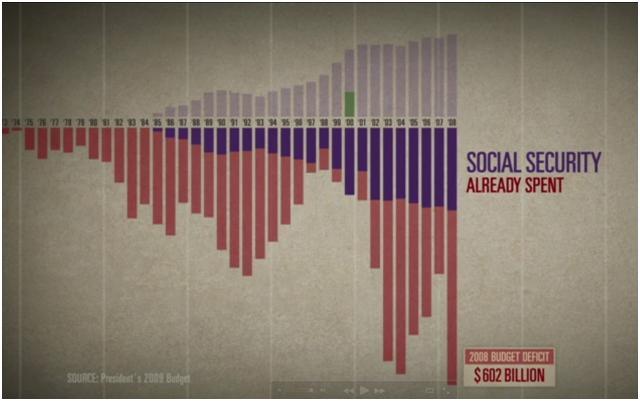Review of IOUSA
Executive Summary
- IOUSA
- Our Take on IOUSA
- Where The Money for the Government Comes From
- Combined Deficit
- Social Security Deficit
IOUSA is a movie produced by concentrated power to pave the way for policy changes that benefit the ultra-wealthy. It’s crooked agenda went unnoticed by the Sundance Film festival where it won an award. It is award worthy, it is the best financial propaganda film of 2009.
IOUSA
This is a well-produced video that describes the problems that the nation faces in regards to its long-term finances. The highlight of the video is a number of graphics that are useful for any number of purposes and some of which we have made screen shots of here.
The Problem with IOUSA
The problem with IOUSA is what it does not say. The obvious conclusion is that government spending needs to be cut. However, it does not say where. One look at the groups that are behind the movie and part of a traveling group of economists, along with the head of the Office of Management and Budget, who is taking a disturbing political tact, for an office that is supposed to be not politicized. This group includes the Brookings Institute and the Heritage Foundation. The movie attempts to present these people as a broad spectrum of the country, when in fact, they represent the financial elite of the country. This movie has the distinct feeling of being a platform for cutting social services to the normal person. Big money hates these programs and hates the fact that money they pay in taxes goes to the non-elites, even though most of their income is not earned in the traditional economic sense, but is either a government granted monopoly (in the case of Exxon or Citibank) or simply a return on previously earned capital.
Furthermore, big money spends a great deal of time lobbying to cut these programs. One of the great scams is the singling out of Medicare as a wasteful program that will drastically increase the budget to unsustainable proportions. However, what is unsaid is that they oppose any legislation to reduce the costs of health care because “that would be socialist.” The ultra wealthy are in favor of any health care change that reduces benefits to normal patients, but not for any legislation that reduces the payout to pharmaceutical companies, medical equipment manufacturers or other elite interests even though there are massive opportunities for cost reductions.
Conclusion
IOUSA can be used for its great graphics, but beyond that, it is primarily propaganda from the ultra rich. They are intent on cutting social spending but don’t have much of an interest in making the system more efficient or cutting wasteful spending like defense spending. All their cuts are aimed at cutting the benefits to other people, even benefits for which they have already paid. The attempt to privatize social security is a despicable act that most of the conservative think tanks are on board with even though it will mean major fees for Wall Street and an era of new poverty for the old.
Our Take on IOUSA
The movie does not make any prescriptions, however, we will. We will take the exact same data which has been presented by IOUSA and demonstrate changes that can and should be made that would both correct the financial shortfalls and improve the economy. We are more qualified to do this than people from The Brookings Institute or The Heritage Foundation because they are completely corrupt and only represent elite interests. We don’t, and unlike these institutions, we don’t sell research for money. Want evidence, both these institutions were in favor of the financial “innovation” and lack of regulation that lead to the meltdown of the system. That is what power means, never having to apologize for being wrong.
Debt that is Allocated to Which Causes

Where The Money for the Government Comes From
Notice how little comes from corporate income taxes. Why is that? How come individuals pay 4x as many taxes as corporations? This shocking, Microsoft, GE all the biggest and smallest companies pay ¼ as much as the employees of these companies. (the payroll taxes cannot be included because they are simply reductions from wages to pay for things like Social Security. How did this escape the attention of the makers of the movie? Clearly, Corporate income taxes should be increased. They appear to be getting a free ride off the system. Also, businesses receive all types of corporate welfare, so they get a lot of that money back. It would be interesting to see what their real tax burden would be after this money is decreased from their taxes.

Annual Federal Budget Deficits and Social Security Surpluses
This is an excellent graph; it shows that while the Federal government has run a perpetual deficit since 1973 (except for 3 years under Clinton) Social Security has been running surpluses (most likely because the baby boomers are working and not yet retired.) However, the next graph shows an even bigger problem.

Combined Deficit
In order to understand this following graph it’s important to understand how Social Security works. It is the federal law that when a surplus of Social Security is attained in any year, that the surplus is used to purchase Treasury Bills. These are stores of value for when the money will be used (when the boomers retire). However, it is strange because it is a loan the government is giving itself. This to us does not seem like the right way to do this, it would be preferred if that money were placed in a bank. However, this is also confusing because a bank is really just a government setup fractional reserve banking system. The short synopsis of this is that the US has not been able to maintain surpluses because it spends above and beyond of the social security surplus. This means this will become more expensive for the country when more people retire due to the population cohort. However, what is left out of this is many companies have also underfunded their pension obligations, so this is a problem for both government and private industry. Also undiscussed is how the 401k program was used to drop the traditional pension, which was a far better deal for workers. IOUSA chooses to focus on the government’s lack of discipline rather than the lack of discipline in private companies because The Heritage Foundation and Brookings Institute are paid for by private companies. No big surprise there. Can we ask where the chart that shows the average underfunding of the US pension, or how far depreciated American’s 401ks are after the financial meltdown, or how people have lost their retirement because they bet on a speculative housing bubble arranged by the Fed and corrupt banking interests? Oh, that chart is not available for some reason.

Social Security Deficit
This chart shows the social security deficit out to 2048. Clearly it is large, however, it should in the early part of this graph because the boomers retire. However, it’s hard to see why it persists all the way out to 2031. A typical boomer is 58 right now. 2031 is 22 years out, so that is 80 years old, which is when many will pass on, and stop collecting Social Security benefits. This would not ordinarily be a problem, but the government will have to pay that out of present revenues, which will be a stress on the economy.

The movie has a second graph which shows the massive costs of Medicare, however this is a Chimera, it is based upon a continuation of our present health care system that enriches specific interests and provides the 37th best health care in the world at twice the average cost of comparable countries (Sweden, Denmark, etc..) Continuing to talk about the burden of health care costs when they could so easily be reduced is deceptive. This post explains how to decrease health care cost by $280 billion in direct costs per year immediately, and roughly $480 in combined direct and indirect costs) and increase the quality of the health care system. Of course, it won’t be done because there is no free ride for concentrated power, thus it is called “socialist.” This is the official description for any program that is logical, fair and benefits the actual population of the country in question.